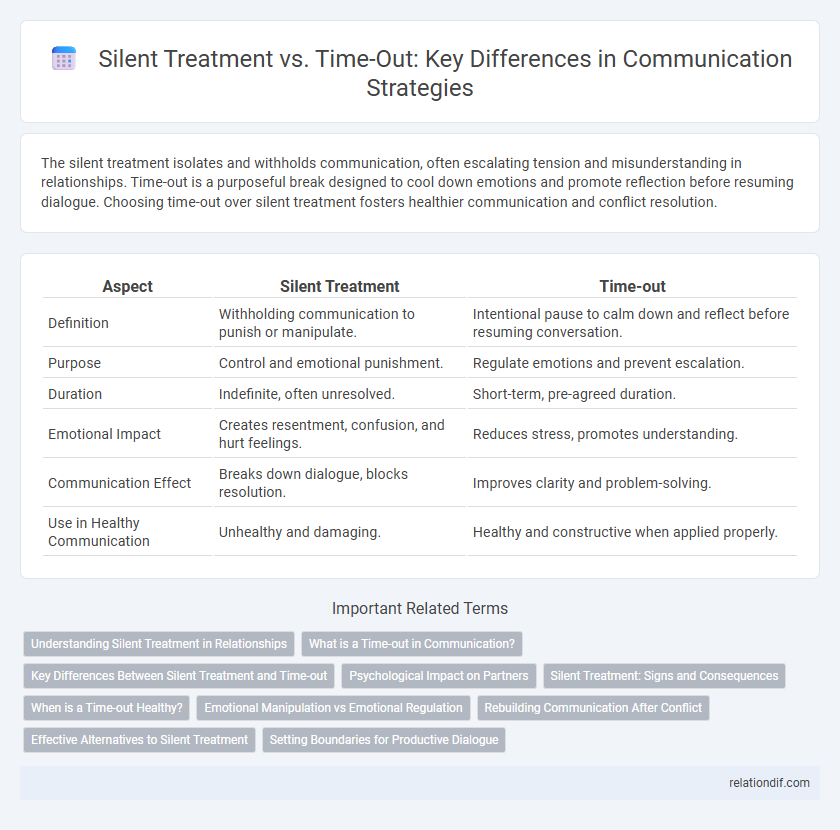The silent treatment isolates and withholds communication, often escalating tension and misunderstanding in relationships. Time-out is a purposeful break designed to cool down emotions and promote reflection before resuming dialogue. Choosing time-out over silent treatment fosters healthier communication and conflict resolution.
Table of Comparison
| Aspect | Silent Treatment | Time-out |
|---|---|---|
| Definition | Withholding communication to punish or manipulate. | Intentional pause to calm down and reflect before resuming conversation. |
| Purpose | Control and emotional punishment. | Regulate emotions and prevent escalation. |
| Duration | Indefinite, often unresolved. | Short-term, pre-agreed duration. |
| Emotional Impact | Creates resentment, confusion, and hurt feelings. | Reduces stress, promotes understanding. |
| Communication Effect | Breaks down dialogue, blocks resolution. | Improves clarity and problem-solving. |
| Use in Healthy Communication | Unhealthy and damaging. | Healthy and constructive when applied properly. |
Understanding Silent Treatment in Relationships
Silent treatment in relationships often functions as a passive-aggressive communication tactic where one partner deliberately ignores or withdraws interaction to express displeasure or exert control. This behavior can harm emotional connection, escalate misunderstandings, and create barriers to resolving conflicts effectively. Understanding silent treatment requires recognizing its roots in unmet needs, fear of confrontation, or attempts to punish, highlighting the importance of addressing underlying issues through open, empathetic dialogue.
What is a Time-out in Communication?
A time-out in communication is a deliberate pause taken by one or both parties to cool down and gather their thoughts before continuing a conversation. Unlike the silent treatment, which involves withholding communication to punish or manipulate, a time-out aims to prevent escalation and promote constructive dialogue. Effective time-outs include setting a clear intention to resume the discussion later, ensuring emotional regulation and mutual respect.
Key Differences Between Silent Treatment and Time-out
Silent treatment involves deliberately withholding communication to punish or manipulate, often escalating emotional distress, whereas time-out is a self-imposed or mutually agreed break to cool down and prevent conflict escalation. Silent treatment is passive-aggressive and damaging to trust, while time-out promotes emotional regulation and constructive problem-solving. Understanding these key differences helps foster healthier communication and relationship dynamics.
Psychological Impact on Partners
Silent treatment often leads to feelings of rejection and anxiety, triggering emotional distress and eroding trust between partners. Time-outs, when used constructively, provide space for emotional regulation and reflection, reducing immediate conflict without causing long-term psychological harm. Consistent communication during time-outs fosters mutual understanding and resilience, whereas prolonged silent treatment risks deepening emotional wounds and increasing relational tension.
Silent Treatment: Signs and Consequences
Silent treatment manifests through intentional withdrawal of communication, marked by ignoring, avoiding eye contact, and refusing to answer questions. This behavior often leads to increased emotional distress, fostering feelings of rejection, anxiety, and decreased self-esteem in the recipient. Prolonged silent treatment can severely damage relationships by eroding trust and creating barriers to resolving conflicts effectively.
When is a Time-out Healthy?
A time-out becomes healthy when used as a deliberate strategy to pause emotions and prevent conflict escalation, allowing individuals to regain composure and perspective. It is effective when both parties agree on the break and use the time to reflect rather than avoid communication. In contrast to silent treatment, a healthy time-out fosters emotional regulation and constructive dialogue, supporting conflict resolution and relationship growth.
Emotional Manipulation vs Emotional Regulation
Silent treatment often serves as a form of emotional manipulation, withholding communication to exert control and induce guilt. In contrast, time-out functions as a healthy emotional regulation strategy, providing temporary space to cool down and reflect without escalating conflict. Understanding these differences is essential for fostering constructive dialogue and maintaining psychological well-being in relationships.
Rebuilding Communication After Conflict
Silent treatment often creates emotional distance that hinders effective communication, whereas time-out provides a structured pause for emotional regulation. Implementing time-outs allows individuals to cool down and reflect, facilitating clearer, more respectful dialogue when re-engaging. Rebuilding communication after conflict requires intentional efforts to express feelings openly and listen actively, restoring trust and understanding.
Effective Alternatives to Silent Treatment
Effective alternatives to silent treatment include time-outs, which allow individuals to cool down and reflect without escalating conflict. Time-outs promote healthy communication by providing space for emotional regulation and preventing misunderstandings. Implementing time-outs encourages mutual respect and creates opportunities for constructive dialogue and resolution.
Setting Boundaries for Productive Dialogue
Silent treatment often creates barriers by withholding communication, hindering trust and problem-solving in relationships. Time-out, when implemented as a mutual pause, allows individuals to cool down and reflect, fostering respectful boundaries and preventing escalation. Establishing clear expectations for time-outs encourages productive dialogue and emotional regulation while avoiding the damaging effects of silence as punishment.
Silent Treatment vs Time-out Infographic

 relationdif.com
relationdif.com